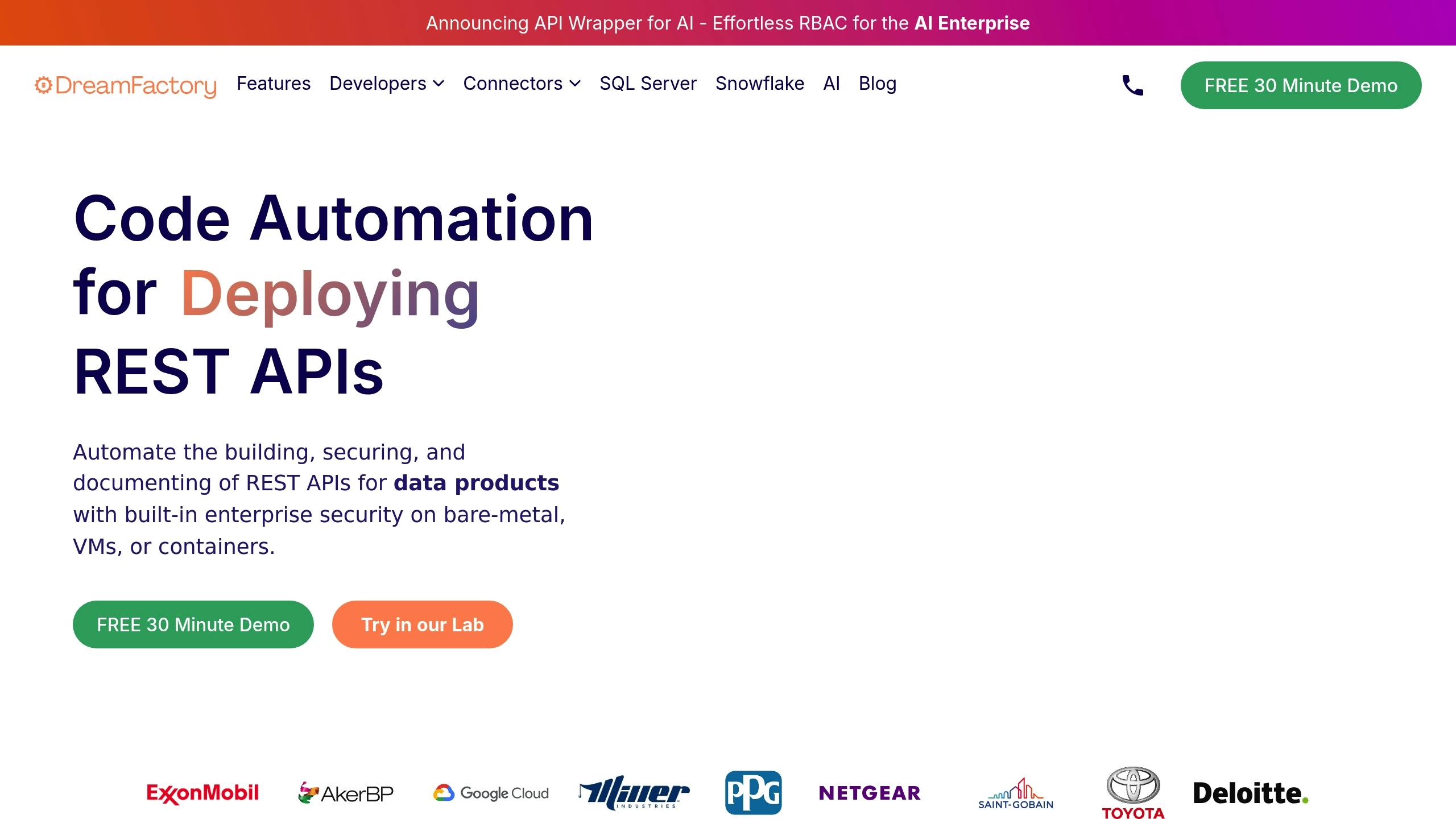Generative AI is transforming how businesses operate, with 74% of enterprises already deploying it in production by 2025. The technology offers measurable benefits like a 1.7x ROI and cost reductions of 26–31% in key areas like supply chain and customer operations. But with rapid adoption comes serious risks - data breaches, AI bias, and compliance issues are top concerns. For instance, 57% of employees admitted to sharing confidential material with public GenAI tools, exposing companies to financial and reputational harm.
To succeed with GenAI, organizations need a structured approach focusing on three key pillars:
Governance: Clear policies and a dedicated governing body to manage risks and ensure compliance.
API Gateways: Secure, scalable access to GenAI services, with robust authentication, encryption, and traffic management.
Guardrails: Measures to prevent misuse, such as input validation, bias detection, and content moderation.
This framework not only mitigates risks but also ensures businesses can safely leverage GenAI's potential to drive innovation and efficiency.
Introduction to the Generative AI Governance Framework
Governance Models: Managing GenAI Oversight
Managing GenAI effectively requires a structured approach that balances innovation with responsibility. As companies weave GenAI into their operations, having solid governance structures becomes essential for secure and scalable implementation. In fact, businesses with strong AI governance are three times more likely to meet their AI goals. This makes governance not just a compliance measure but a key competitive advantage.
A comprehensive GenAI governance framework - covering infrastructure, data, models, and interfaces - lays the foundation for a unified approach across all business functions. This is especially critical as regulatory scrutiny intensifies. By 2026, half of the world's governments are expected to enforce responsible AI regulations, and 75% of enterprises will likely face regulatory challenges related to AI. Organizations that lag behind may find themselves scrambling to comply, while proactive companies gain a clear edge.
"We find ourselves in a new and exciting time when it comes to AI and its current and prospective effects on society and business. Conceptualizing a coherent way for organizations to approach AI governance in the wilds of this rapidly developing environment becomes crucial. I see this effort as a significant and important step forward in this vital space, and I commend the authors as insightful early movers!"
Douglas F. Prawitt, PhD, CPA, Director of Brigham Young University School of Accountancy and Lead Director of COSO Board
Building a Central Governance Framework
To manage GenAI effectively, organizations need a centralized governance structure led by a core governing body. This group should include an ultimate decision-maker and key leaders from various departments. A written charter serves as the foundation, outlining objectives, roles, responsibilities, meeting schedules, and accountability measures. With 85% of CEOs predicting that AI will reshape their businesses within the next five years, this charter becomes a vital business document, not just an IT policy.
The governance framework must address diverse risks that could impact the organization:
|
GenAI Risk Categories |
Description |
|---|---|
|
Strategic |
Risks tied to aligning AI with business goals and overall strategy |
|
Financial |
Costs of implementation, maintenance, and potential financial losses from errors |
|
Operational |
Issues like data quality, model performance, and system reliability |
|
Compliance |
Ensuring adherence to laws, regulations, and industry standards |
|
Technological |
Threats such as security vulnerabilities, data breaches, and model drift |
|
Reputational |
Damage to the organization's image due to biased or unethical AI practices |
|
Ethical |
Concerns about fairness, transparency, and accountability in AI use |
|
Human Capital |
Workforce challenges, including job displacement and skill gaps |
A cross-functional GenAI center of excellence (COE) is essential for centralized management and support. This COE acts as the operational hub, providing expertise and resources for deploying GenAI solutions. Currently, only 58% of organizations have conducted preliminary AI risk assessments, emphasizing the need for regular evaluations and clear escalation procedures for critical issues.
GenAI Governance Roles and Duties
Clear roles and responsibilities are key to successful GenAI governance. A "three lines of defense" model ensures that each organizational level has a distinct function:
- Governing Body: This top-level group provides strategic direction and is accountable for AI policies and procedures. It sets targets, evaluates AI portfolios, and approves use cases that align with the organization's risk tolerance.
- Operational Layer: Managers, technical specialists, and procurement teams handle day-to-day implementation. For example, product and business owners oversee resource allocation and ensure AI systems meet governance standards.
- Independent Auditors: The third line of defense assesses the effectiveness of governance measures. They provide the governing body with insights into whether risk management efforts are sufficient to meet organizational goals.
Key stakeholders also play vital roles. Chief Data Officers oversee data strategies, while legal and compliance officers ensure adherence to regulations. Data scientists, engineers, and stewards contribute technical expertise, and business leaders align AI initiatives with broader objectives.
"This AI governance framework, which I had the privilege to help shape, epitomizes that by providing a one-page summary ideal for boardroom discussions, alongside a detailed breakdown of controls for practical implementation. It's designed not only to be adopted but also to be adapted, allowing companies to assess their compliance and maturity, identifying areas of strength and opportunities for improvement."
Waseem Samaan, CPA, CIA, Vice President, Global Head of Internal Audit & Risk at Boomi
Regulatory and Ethical Compliance
Once roles are clearly defined, aligning governance with regulatory standards becomes a priority. It's important to distinguish between AI compliance, which focuses on adhering to legal and ethical standards, and AI governance, which manages risks and provides strategic oversight.
Regulations vary by region. For instance, the EU AI Act enforces strict, risk-based classifications, while the U.S. relies on the voluntary NIST AI Risk Management Framework (AI RMF). Major regulatory frameworks include the EU AI Act, GDPR, NIST AI RMF, and OECD Principles. The AI RMF, in particular, offers a flexible structure to help organizations manage AI risks throughout their lifecycle.
The need for robust governance is underscored by real-world challenges. For example, facial recognition software misidentifies Black and Asian faces 10 to 100 times more often than white faces, and AI-driven cyberattacks have surged by 300% between 2020 and 2023. To address these risks, organizations should:
- Conduct risk assessments to identify high-risk applications and compliance gaps.
- Develop internal AI ethics policies aligned with global standards.
- Implement continuous monitoring and auditing to detect biases or compliance violations.
- Train employees on AI ethics and ensure transparency in AI decision-making.
These measures not only help mitigate risks but also strengthen trust and accountability in AI systems.
API Gateways: Secure and Scalable GenAI Access
Once governance structures are in place, organizations need a solid technical framework to manage GenAI access securely and efficiently. This is where API gateways come into play. They act as a secure bridge between enterprise systems and GenAI services, enforcing security policies, managing authentication, limiting usage rates, and centralizing monitoring. With 90% of web traffic flowing through some form of API, and the average cost of an API security breach reaching $6.1 million, ensuring proper gateway controls is not just a technical necessity but a critical business priority.
This centralized management becomes even more essential as organizations expand their GenAI deployments, requiring consistent security measures across multiple AI services and models.
"We're certainly in the early days of this emerging API security space, but in thinking about API security going forward, it's going to become the very foundation for modern applications."
-Tyler Reynolds, Senior Solution Architect at Kong
API Gateways in GenAI Integration
API gateways serve as protective barriers between users and GenAI microservices. They ensure that only authorized individuals can access AI capabilities, while safeguarding sensitive enterprise data. By providing a unified API interface, gateways simplify technical complexities, offering access to AI models based on user roles and responsibilities.
Organizations can deploy GenAI services either in the cloud or on internal systems. Ingress gateways manage external access, while egress gateways control how resources are consumed internally. These gateways are designed to handle the heavy computational demands, slower response times, and complex contextual processing that often come with GenAI, all without compromising security or performance.
Modern GenAI gateways centralize essential functions like authentication, encryption, and logging. They also implement advanced measures such as token-based rate limiting, content moderation, bias detection, and ethical safeguards.
"The two dimensions of API management are the knowledge of the existence of the API and the application of API governance on it. Ideally, all APIs should be known and managed."
-Ahmed Koshok, Senior Solution Architect at Kong
API Security and Traffic Management Practices
Protecting GenAI APIs requires a layered security approach that addresses both traditional API vulnerabilities and risks unique to AI. Authentication methods like OAuth 2.0 and JWT form the backbone of secure access control. Additionally, role-based access control (RBAC) ensures users interact only with AI models appropriate for their roles.
Data protection is another cornerstone, requiring encryption of sensitive information both at rest and in transit using protocols like SSL/TLS. Input validation is critical to prevent malicious data or code from compromising AI models or causing unintended behavior. Organizations can also use prompt templates to structure user inputs and system prompts to constrain model behavior.
To manage traffic effectively, advanced token-based rate limiting and dynamic thresholds can adjust based on factors like IP addresses, API keys, and request frequency. The growing scale of API threats underscores the importance of these measures. For instance, a report from India in 2025 documented a 3,000% surge in API-targeted DDoS attacks over three months, with one attack generating 1.2 billion malicious requests. Dynamic rate limiting that adapts to real-time conditions is crucial for managing such situations.
"The challenge is balancing flexibility for legitimate users while blocking malicious actors on-the-fly, especially in environments where traffic volumes soar unpredictably."
Additional security practices include deploying Web Application Firewalls (WAF) to restrict access based on predefined rules. Semantic caching can also reduce redundant API calls by storing AI responses for similar queries, improving efficiency and reducing exposure to attacks. Continuous monitoring of API traffic helps identify unusual patterns, slow response times, or potential vulnerabilities before they escalate.
"The scary thing about these breaches is that the exploited APIs worked exactly as they were designed. It's not about a bug in the code - it's about simply leveraging the predictable nature of an API against itself to make it do something the developer didn't intend."
-Tyler Reynolds, Senior Solution Architect at Kong
Using DreamFactory for API Generation

To meet these rigorous security and efficiency standards, organizations can turn to platforms like DreamFactory. This tool simplifies API management and integration with GenAI systems by automatically generating REST APIs for various data sources, eliminating the need for manual coding and reducing potential security risks.
DreamFactory's instant API generation maps database schemas directly to REST API schemas, saving developers both time and effort. This automation can save up to $45,719 per API while cutting common security vulnerabilities by 99%.
The platform offers robust security features tailored for GenAI, including Role-Based Access Control (RBAC), API key management, and support for authentication methods like OAuth, SAML, and Active Directory. These features ensure safe access to enterprise data while maintaining compliance with organizational policies.
"DreamFactory streamlines everything and makes it easy to concentrate on building your front-end application. I had found something that just click, click, click... connect, and you are good to go."
-Edo Williams, Lead Software Engineer, Intel
DreamFactory also supports server-side scripting with languages like NodeJS, PHP, and Python, enabling businesses to implement custom logic and tailor APIs for specific AI use cases. Its flexibility extends to deployment options, supporting environments like Kubernetes, Docker, and Linux. Additionally, the platform provides auto-generated Swagger API documentation, simplifying integration with GenAI applications and making it easier for teams to understand endpoints and data structures.
"DreamFactory is far easier to use than our previous API management provider, and significantly less expensive."
-Adam Dunn, Sr. Director, Global Identity Development & Engineering, McKesson
With support for over 20 connectors, including Snowflake, SQL Server, and MongoDB, DreamFactory seamlessly integrates with the diverse data sources GenAI applications rely on. Its compliance with GDPR and HIPAA ensures organizations can safely utilize AI capabilities while adhering to regulatory standards.
Guardrails: Protecting Enterprise GenAI Deployments
Once API gateways are secured, the next step is implementing guardrails to ensure GenAI operations remain safe and ethical. These measures are essential as enterprises face growing operational risks. For instance, over 13% of employees share sensitive information with GenAI applications, and 22 out of every 10,000 enterprise users post source code on ChatGPT monthly. A Deloitte study highlights risk management and regulatory compliance as the top concerns for organizations scaling their GenAI strategies. By reinforcing the API security measures discussed earlier, guardrails help maintain operational integrity.
Why GenAI Operations Need Guardrails
Deploying GenAI in enterprise settings comes with risks like data privacy breaches, algorithmic bias, adversarial attacks, and harmful content generation. Data privacy concerns are particularly pressing - Samsung, for example, banned GenAI tools after employees inadvertently leaked sensitive data through public prompts. Public sentiment echoes these worries, with 52% of Americans expressing more concern than excitement about AI's growing presence.
"The alignment problem is the task of building AI systems that reliably pursue the objectives we intend, even if these objectives are difficult to specify." - Nick Bostrom, director of University of Oxford's Future of Humanity Institute
Guardrails address these challenges by setting clear boundaries for how large language models handle user queries, access sensitive data, and interact with external information. They also protect against vulnerabilities like prompt injection, ensure compliance with regulations, and reduce the likelihood of harmful outputs.
Setting Up Effective Guardrails
Creating effective guardrails requires a layered approach, combining various strategies to tackle different aspects of GenAI operations. Below is a breakdown of key guardrail types and their purposes:
|
Guardrail Type |
Purpose |
Key Practices |
|---|---|---|
|
Hallucination Guardrails |
Minimize false or fabricated outputs by grounding responses in verified data |
Use Retrieval-Augmented Generation (RAG). Require source attribution. |
|
Regulatory-Compliance Guardrails |
Ensure alignment with privacy laws like GDPR and HIPAA |
Apply privacy-by-design principles. Use CBAC and role-based access. Automate policy enforcement. Maintain audit trails. |
|
Alignment Guardrails |
Keep model behavior consistent with business rules and prevent manipulation |
Use robust system prompts. Protect against prompt injection. Conduct red-teaming exercises. Monitor for behavioral drift. |
|
Validation Guardrails |
Ensure inputs and outputs are reliable and safe |
Sanitize and validate inputs. Filter and verify outputs. Apply rate limits. Log and monitor interactions. |
|
Appropriateness Guardrails |
Detect and prevent toxic, biased, or inappropriate content |
Use NLP classifiers to flag harmful language. Apply pre- and post-generation filters. Fine-tune models with fairness-focused datasets. |
Organizations should prioritize data privacy controls as a foundational step. Screening data inputs to identify potential risks can prevent models from behaving unpredictably or operating outside validated conditions. Implementing strong data protection measures and restricting access to GenAI systems are critical steps.
Another essential layer is content moderation, which involves identifying and filtering content that could damage an organization's reputation or erode trust in the model. NLP-based classifiers can flag inappropriate content before it reaches users.
Prompt engineering is another effective tool for maintaining model alignment with business goals. Industry leaders use advanced techniques to address this challenge. For example:
-OpenAI employs system message boundaries and reinforcement learning from human feedback (RLHF).
-Anthropic trains its Claude models using Constitutional AI, embedding specific values during training.
-Meta uses red-teaming and access controls for its LLaMA models.
-Microsoft incorporates Prompt Shields and data-aware AI in its Microsoft 365 Copilot.
Post-processing filters add another layer of safety by analyzing model outputs to block harmful or biased content before delivery. Additionally, dynamic policy updates allow organizations to adapt their guardrails as threats evolve or business needs change, ensuring long-term effectiveness.
Real-world examples highlight the value of guardrails. For instance, the Mayo Clinic integrates human-in-the-loop reviews for clinical notes, ensuring both safety and accuracy.
"We used to get security from obscurity." - Rama Akkiraju, vice president of AI for IT at NVIDIA
DreamFactory's Monitoring and Compliance Tools
DreamFactory offers a robust example of a multi-layered approach to guardrails, combining monitoring tools with customizable protections. Its Role-Based Access Control (RBAC) system is a cornerstone of its framework, allowing organizations to define precise user permissions and restrict GenAI access to authorized personnel.
"Role-Based Access Control (RBAC) simplifies API permission management by assigning users to predefined roles, each with specific permissions." - Adrian Machado, Engineer
RBAC has been shown to reduce security incidents by up to 75%, providing a scalable way to protect enterprise systems while maintaining compliance.
DreamFactory also supports custom guardrail logic through server-side scripting in Python, PHP, NodeJS, and V8JS. This feature lets organizations embed specific business rules, validation checks, and compliance requirements directly into their workflows. Custom scripts can validate inputs, filter outputs, and enforce organizational policies.
The platform's logging and reporting features enhance visibility, enabling users to monitor guardrail effectiveness and ensure compliance. Integration with the ELK stack (Elasticsearch, Logstash, and Kibana) allows organizations to analyze moderated prompts and responses, identify risks, and track anomalies using customized dashboards.
DreamFactory’s compliance framework aligns with major standards, including GDPR, PIPEDA, COPPA, HIPAA, and FERPA. Its security measures also map to the Cloud Security Alliance's (CSA) Consensus Assessments Initiative Questionnaire (CAIQ v3.0.1), which corresponds to frameworks like SOC, COBIT, FedRAMP, HITECH, ISO, and NIST.
One success story involves a leading U.S. energy company, which used DreamFactory to create REST APIs on Snowflake. This solved integration challenges, enabling predictive analytics and operational AI models. The result? An 85% reduction in development time.
Summary and Key Points
Implementing GenAI in enterprise settings requires a well-thought-out strategy built on three key elements: governance, API gateways, and guardrails. Together, these components form a framework that enables organizations to leverage GenAI effectively while minimizing risks.
Governance, Gateways, and Guardrails: A Closer Look
Governance lays the groundwork for deploying GenAI responsibly. AI Risk Governance involves the systems, policies, and teams needed to manage risks tied to AI usage. A solid governance structure brings together experts from Security, Risk, Compliance, AI/ML teams, Legal, and Business Units, ensuring comprehensive oversight and policy development. This is critical, especially as more than 60% of enterprises used GenAI for at least one critical business process in 2024.
API Gateways serve as the backbone of GenAI operations, enabling seamless management, connectivity, and security across multiple large language models. These gateways offer centralized control and real-time monitoring, ensuring both security and performance. Marco Palladino, CTO and Co-Founder of Kong Inc., highlights their importance:
"As artificial intelligence continues to evolve, organizations must adopt robust AI infrastructure to harness its full potential".
Guardrails function as protective measures, ensuring safe and compliant use of GenAI. They monitor usage in real time and enforce policies to address risks like data breaches, algorithmic bias, and harmful outputs. The value of guardrails is evident - companies with advanced AI security frameworks are 67% less likely to face data breaches during GenAI adoption.
These three elements create a robust defense strategy. Traditional governance, risk, and compliance (GRC) tools fall short for AI because they lack features like model-level visibility and AI-specific controls. This has led to the rise of AI Risk Governance Platforms, which help CISOs, AI Governance Leads, and Compliance Officers manage the AI lifecycle effectively.
With this framework in place, enterprises can focus on operationalizing these principles to fully realize GenAI's capabilities.
Next Steps for Enterprise Implementation
To move forward, enterprises should start by establishing formal AI governance programs. Gartner predicts that by 2026, 60% of organizations will have such programs to address risks like model drift, data privacy violations, and regulatory challenges.
Building on the governance, gateways, and guardrails framework, enterprises should take the following steps:
Form a cross-functional governance team: This team, including IT, data science, legal, security, and business units, should define policies for data quality, privacy, ethics, compliance, and lifecycle management.
Focus on high-value use cases: Prioritize the most impactful or highest-risk AI initiatives to demonstrate early success.
Strengthen data management: Implement a unified data catalog, continuous quality monitoring, and regular reviews to ensure models perform well and stay compliant.
Embed security controls: Tag sensitive data, apply tiered access controls, and integrate zero-trust measures like identity-based access and API rate limiting [55, 61].
Monitor continuously: Regularly review model performance, gather user feedback, and maintain audit-ready documentation.
Foster a responsible AI culture: Train teams on governance policies, ethical AI principles, and their roles in maintaining responsible practices.
By treating AI as a product, organizations can achieve faster experimentation and deployment cycles. For instance, businesses can reduce testing time by 25–60% and accelerate deployments by 70–90% using tools like MLflow and CI/CD pipelines. McKinsey estimates that GenAI could contribute up to $4.4 trillion in annual productivity gains, making the investment in governance, gateways, and guardrails well worth the effort.
The key to successful GenAI implementation lies not just in technology but in building the right organizational framework to support it.
FAQs
What are the main risks of using Generative AI in enterprises, and how can businesses address them?
Generative AI brings with it a range of challenges for businesses, such as security vulnerabilities, data privacy concerns, biased outputs, and inaccurate results. If these issues aren't handled carefully, they can result in financial setbacks, harm to a company's reputation, and disruptions in daily operations.
To tackle these concerns, companies should establish a solid governance framework. This means enforcing strict access controls, conducting regular model evaluations, and maintaining ongoing monitoring of AI systems. It's also crucial to define clear accountability, ensure compliance with regulations, and validate AI outputs to maintain reliability. On top of that, encouraging transparency and ethical standards can help reduce bias and foster trust in AI-driven solutions.
With strong oversight and a proactive approach to risk management, organizations can integrate Generative AI into their workflows effectively while keeping potential pitfalls in check.
How do API gateways help secure and scale GenAI services in an enterprise?
API gateways are essential for securing and scaling GenAI services within organizations. They bolster security by implementing authentication, rate limiting, and monitoring, which guard against unauthorized access, misuse, and potential threats.
On the scalability front, API gateways handle heavy traffic loads with tools like load balancing, request aggregation, and caching. These capabilities help cut down latency, improve response times, and keep performance steady - even during high-demand periods. They also offer centralized management, simplifying compliance efforts and optimizing resource allocation across the organization.
Why are guardrails important for ethical and compliant use of GenAI, and how can they be effectively implemented?
Guardrails play a crucial role in ensuring that generative AI (GenAI) functions responsibly, securely, and in line with both organizational policies and societal expectations. These safeguards help reduce risks, prevent unintended consequences, and ensure AI aligns with your company's values and standards.
To establish effective guardrails, organizations can take the following steps:
- Set input and output filters to block inappropriate or sensitive content.
- Regularly monitor AI activities to identify and resolve unusual behaviors.
- Implement role-based access controls to restrict sensitive AI functions to authorized personnel.
- Use bias detection tools to encourage fairness and equity in AI-generated results.
By putting these measures in place, businesses can manage GenAI responsibly while staying compliant with ethical and legal standards.
Kevin McGahey is an accomplished solutions engineer and product lead with expertise in API generation, microservices, and legacy system modernization, as demonstrated by his successful track record of facilitating the modernization of legacy databases for numerous public sector organizations.
























 Blog
Blog



